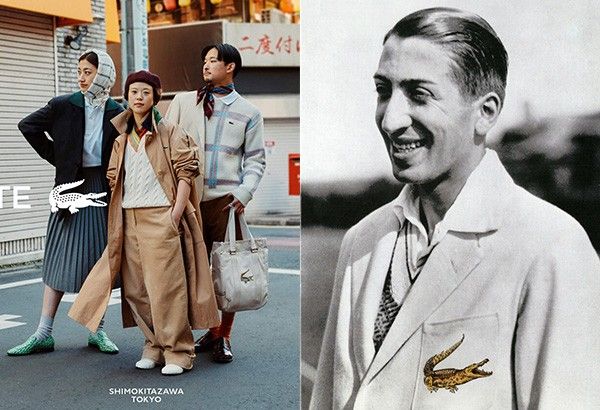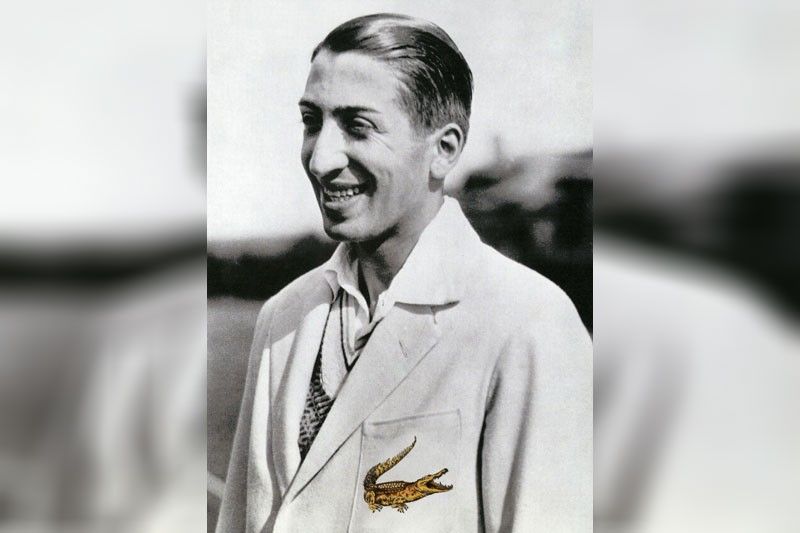Celebrating the 'Crocodile': 90 years of René Lacoste's fashion and genius

MANILA, Philippines — Back in 1933, tennis player René Lacoste founded a clothing company, La Chemise Lacoste, with André Gillier, owner and president of the largest French knitwear manufacturing firm at that time.
As business partners, they began to produce the revolutionary tennis T-shirt designed by Lacoste and worn by him on the tennis courts, with the crocodile logo embroidered on the chest. Inspired by the free elegance of Lacoste’s own pro sporting family and friends, the shirt was first loved by sports players and then the Crocodile spread throughout the world like a unique cultural cross-pollination, influencing street culture, popping on to fashion’s runways, and tracing its way through the vintage retro scene and being inscribed into pop culture.
The Crocodile is now an emblem for many, with the brand creating a strong impact on fashions and cultures so widely and diversely spread globally. With time, the brand’s values of French elegance, movement, savoir-faire, creativity and reinvention have transitioned seamlessly throughout every decade.
This year, Lacoste celebrates the 90th anniversary of the iconic Crocodile with eight of its compelling contemporary sub-cultures.
The Lacoste communities that the world will meet this year are Lacosteiros from São Paulo, Brazil; vintage fashion collectors from Tokyo, Japan; French rap lovers from Paris and its suburbs in France; amateur tennis players from New York City, USA; vintage Lacoste passionates from Marseille, France; amateur golfers from Miami, USA; Roland Garros fans from Paris, France and amateur and professional tennis players from Seoul, South Korea.

90th anniversary campaign
With such rich cultural inspiration, Lacoste was poised to create a meaningful, emotion-charged 90th anniversary campaign. But how would the brand spotlight the uniqueness of its communities, as stylistically different as they are geographically distanced? By taking its role as a cross-cultural connector to heart, creating a campaign of “Impossible Encounters,” made possible through the magic of style and cinema.
The campaign bridges pairs of its eight subcultures — Heliopolis, Saõ Paulo to Shimokitazawa, Tokyo; Melreese Golf Club, Miami to Mini Golf du Prado, Marseille; Les Ardoines, Greater Paris to Harlem 125th St Station, New York City; Séoul, to Roland Garros, Paris — each shot in their own meaningful locations and contexts, to highlight both their differences and their unexpected similarities. The shots create a unique symmetry in their favorite meet-up spots, surprising parallels in clothing color palettes, and striking contrast between their minimalist/maximalist spirits.
This campaign continues to build upon the fresh, humorous, pop-cultural editorial language, established through the brand’s iconic ad series “Unexpected Encounters,” launched in 2022.
Its authenticity and nuance are in large part thanks to collaboration with local cultural “curators” who ensure the representation of each culture. Curators include Lacosteiros expert Fernanda Souza (São Paulo) and street style specialist Motofumi “Poggy” Kogi (Tokyo).
Irish photographer Ronan Gallagher’s documentary approach, strong color and fashion sensibility combine to inject colorful pop energy into each still shot. Having shot its iconic 2022 brand campaign, he continues to develop a unique visual language for the ever-evolving brand.
London-based director and youth culture lover Yoni Lappin infuses wit into the short ad films, bringing together “scenarized” encounters with spontaneous authenticity.
French digital director Chris Saulnier’s social-first talents bring unstoppable dynamism to a profoundly anthropological project, bringing together community interviews, behind-the-scenes moments and playful style explorations.
The campaign is co-imagined by Lacoste and French creative agency BETC.

Popping into local communities
Throughout the year, Lacoste will open an innovative pop-up in each sub-culture’s local area. Pop-up themes include vintage stores, flea markets, tennis playgrounds, live concerts and exhibitions.
The objective is to create value for each community, giving them the chance to enter a more intimate brand conversation and collaborate in an open format, connecting through their own unique cultural touchpoints and passions.
Each pop-up will also offer limited-edition products with relevance to each community, including polo re-editions, which will get Lacosteiros hearts racing in Sao Paulo; a tennis-inspired capsule for fans of Roland Garros and a vintage, Made in Japan selection from curator Poggy, in Tokyo.
Fashion purveyor and genius
Born in Paris in 1904, Lacoste was immersed in sport from an early age, inspired by his father, a rowing enthusiast.
René’s passion, however, was tennis. He won his first tournament at age 17 in 1921. He was then spotted by tennis champion Suzanne Lenglen, who became a close friend and mentor on the court, guiding him to move with spontaneity and unique strength.
In 1926, inspired by polo players in London, René began to wear the short-sleeved shirt on the court, giving him even greater freedom of movement, and giving birth to the concept of functional elegance.
In 1933, he met the industrialist André Gillier. Together they conceived of the Lacoste L.12.12 polo shirt, a revolutionary piece of design. L stands for Lacoste, 1 for the unique fabric called cotton petit piqué, 2 for the short-sleeved version and 12 for the number he picked for this version. Against the advice of his friends, he decided to embroider his famous signature Crocodile on it and, thus, the first polo was created.
René’s inventive spirit also gave birth to some of the sporting world’s most important non-fashion innovations.
In 1928, he invented the tennis ball machine to improve his technique. The machine went on to train generations of players. In 1963, he revolutionized the tennis world with the invention of the steel tennis racket. The invention provided superior aerodynamics and paved the way for the modern tennis racket. In 1971, he invented the damper, a new vibration absorption device located in the racket handle.

Where did the 'Crocodile' get its name?
It’s the year 1923, in Boston, USA. Before a tennis match, René Lacoste notices an elegant crocodile skin suitcase in a shop window. His coach promises to give it to him if he wins. He loses. But hearing of the bet and René’s unique tenacity on the court, a journalist nicknames him the "Crocodile.”
In 1926, inspired by his own nickname, Lacoste asks his friend Robert George to design a crocodile. The now famous logo makes its first appearance embroidered on René’s blazer. The legend grows.

The first Lacoste community
René’s tight-knit group of family and charismatic friends were Lacoste’s first community. His wife, Simone Thion de La Chaume, an international golf champion, shared René’s passionate sporting spirit and passed it on to their daughter Catherine, who became one of the greatest golf champions of the 1960s and 1970s.
In Chantaco, the golf club created by Simone’s father, the Lacoste family supported young players, encouraging them to follow their dream of becoming champions, no matter their origins and social categories. Lacoste keeps the value of youth commitment alive to this day, through programs including Durable Elegance and Foundation Lacoste, actively supporting equal opportunity through the power of sport.

Fashion is also a sport
Between rigor and coolness, freedom and elegance, precision and expression, Lacoste stands for fashion sport and French savoir-faire.
Proudly made in France, where Lacoste's unique weaving and knitting technique was born, the brand continues to refine and innovate its sourcing and fabrication processes, looking towards a more sustainable future for people and the planet.
The brand has reshaped the contemporary fashion landscape, through the vision of iconic artistic directors including Christophe Lemaire, Felipe Oliveira Baptisa and Louise Trotter. Today, Creative Design Director, Pelagia Kolotouros, leads the collective studio taking Lacoste into its next chapter.
In the Philippines, Lacoste is exclusively distributed by Stores Specialists, Inc.
RELATED: WATCH: Top 5 sneakers for 2023 — experts, Sneakerfest



















